

30's and 40's
![]()
![]()
![]()
![]()
![]()
Overview
The Second World War changed the experience of space technology from an imaginary fantasy to a sometimes terrible reality. After German V-2 rockets fell on 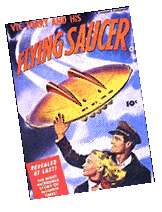 London, the idea of space travel and jet propulsion could never again be purely benign or fanciful. Perhaps it was, in part, this unease with the dawning space age that contributed to the frequent, disturbing sightings of unidentified flying objects, or UFOs, which began in the late 1940s and continued through the 1950s. Stories of seeing flying saucers and of kidnappings by little green men became standard fare in newspapers, magazines, and popular books. Many organizations such as the Aetherius Society and Uranius Foundation were established to study and even greet interplanetary visitors.
London, the idea of space travel and jet propulsion could never again be purely benign or fanciful. Perhaps it was, in part, this unease with the dawning space age that contributed to the frequent, disturbing sightings of unidentified flying objects, or UFOs, which began in the late 1940s and continued through the 1950s. Stories of seeing flying saucers and of kidnappings by little green men became standard fare in newspapers, magazines, and popular books. Many organizations such as the Aetherius Society and Uranius Foundation were established to study and even greet interplanetary visitors.
The advent of television in the 1950s increased the popular interest in space travel and exploration. The comic strips and radio space operas of the 1930s and 40s had already created a market for space adventure, and the development of TV added a new dimension to this popular preoccupation. The first space TV series was "Captain 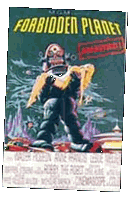 Video," which began in 1949. Then in the 1950s the TV screen was virtually invaded by adventurous space heroes like Tom Corbett Space Cadet, Buzz Cory of the Space Patrol, and Rocky Jones Space Ranger. The 1960s continued the trend with the introduction of shows like "The Jetsons," "Lost in Space," and "Star Trek." Space stories were popular fare in the movies as well, with the production of films like "Commando Cody Sky Marshall of the Universe," "Forbidden Planet," and the extraordinary "2001."
Video," which began in 1949. Then in the 1950s the TV screen was virtually invaded by adventurous space heroes like Tom Corbett Space Cadet, Buzz Cory of the Space Patrol, and Rocky Jones Space Ranger. The 1960s continued the trend with the introduction of shows like "The Jetsons," "Lost in Space," and "Star Trek." Space stories were popular fare in the movies as well, with the production of films like "Commando Cody Sky Marshall of the Universe," "Forbidden Planet," and the extraordinary "2001."
Yet in 1957, the romance of space represented to Americans by Captain Video and Commando Cody was shattered forever by the reality of the launch of the Soviet Sputnik. Until this event, Americans had assumed that they alone were preeminent in the technology of space research, but now American's smug self confidence was battered each night as they looked to the sky to see the small Soviet satellite pass overhead. 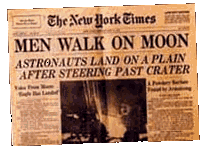 The United States launched its first satellite, Explorer I, in 1958, and ushered in the "Space Race" with the Soviet Union, a contest which would not end until 1969 with the American manned moon landing of Apollo 11. During this decade, the popular American understanding of space changed entirely, from the science-fiction vision of Buck Rogers and Captain Video to the scientific-technological one of NASA. The impact of this change was felt in all arenas of American life, from education to politics to toy manufacturing. In 1966, for example, Mattel introduced the astronaut action figure Major Matt Mason, the first space toy based on actual NASA drawings and plans.
The United States launched its first satellite, Explorer I, in 1958, and ushered in the "Space Race" with the Soviet Union, a contest which would not end until 1969 with the American manned moon landing of Apollo 11. During this decade, the popular American understanding of space changed entirely, from the science-fiction vision of Buck Rogers and Captain Video to the scientific-technological one of NASA. The impact of this change was felt in all arenas of American life, from education to politics to toy manufacturing. In 1966, for example, Mattel introduced the astronaut action figure Major Matt Mason, the first space toy based on actual NASA drawings and plans.
Ray Guns of the 1950s and 1960s
Two factors differentiate the toy space guns of the 1950s and 60s from those produced in the earlier decades. While the earlier guns are made largely from heavy stamped or diecast metal, and a few from aluminum, the later ones are more likely to be fabricated of lithographed tin and/or plastic. In addition, while all of the toy space guns from the 1930s and 40s were made in the United States, a significant proportion of the guns from the 1950s and 60s were made in Japan and some in Europe. Although during this period, Japanese toy guns were imported into the United States in 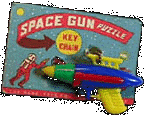 quantity, becoming an important part of the American toy market, toy guns made in Europe were seldom imported to the U.S.
quantity, becoming an important part of the American toy market, toy guns made in Europe were seldom imported to the U.S.
With notable exceptions, American technology generally seemed to excel more with plastic than tin during this period, creating many remarkably beautiful plastic space gun designs like the Smoke Ring Gun by Nu-Age Products and the Planet Jet Gun by Renewal Manufacturing. Still, a few of the most significant and sophisticated American toy space guns of the time continued to be made of diecast metal. Perhaps the most notable is the famous Atomic Disintegrator by Hubley.
The late 1950s and early 60s stands as the end of the great age of American toy space guns. By the mid to late 1960s, with the exception of toy space guns made in Europe, the production of space guns moved largely to Hong Kong and after that to China.
![]()
![]()
![]()
![]()
 |
ATOMIC DISINTEGRATOR The Atomic Disintegrator is one of the most beautiful toy ray guns ever made. Marked by its ornate, baroque casting and striking red grips, it epitomizes the sense of fantasy that characterizes popular space adventure. |
 |
MARTIAN GUIDED WHISTLE WITH JET-BLAST BLOON GUN Featuring a strikingly aerodynamic open-work design, brilliant alternating colors, and an ingenious balloon firing mechanism, this toy is one of the most unusual plastic ray guns produced. Made by Mercury Plastics, "the exclusive producers of Martian toys on planet earth," it shoots "bloon rockets" which blast off for the moon. |
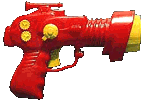 |
AUTOMATIC REPEATING BUBBLE SHOOTING GUN A wonderfully outlandish and almost comic plastic creation, the Bubble Shooting Gun looks more like a cartoon than something resembling a real firearm. Fantastically sculpted with protruding dials, a bulging barrel tip, and other bizzare gizmos, the gun is an example of the best of 1950s "classic plastic." |
